Scandals of Classic Hollywood: Ava Gardner, the Second-Look Girl
by Anne Helen Petersen
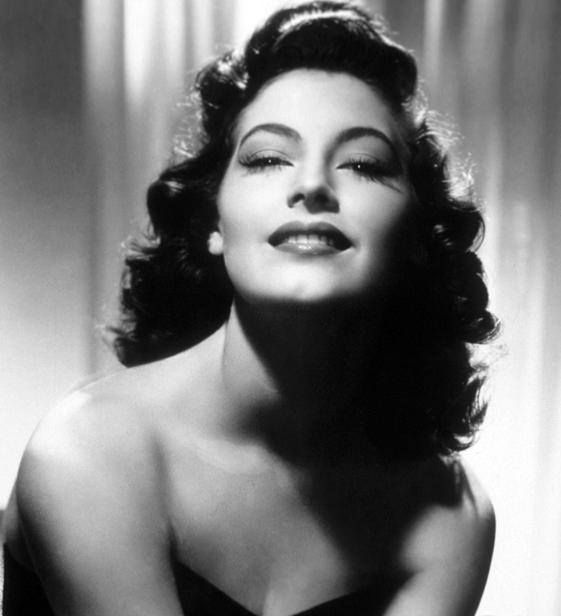
Ava Gardner knew how to pose for the camera. She’d slit her eyes, throw her head at an angle, and the photographer would somehow catch something about her — not elegance or grace, exactly, but something that was strong, sexual, and almost animal, as if she were zeroing in on you, weighing your merits, and readying to pounce. And for most of the ’40s and ’50s, she was Hollywood’s most alluring femme fatale, an image solidified both on and off the screen.
Gardner was the youngest of eight children, raised in near-poverty in North Carolina, where she acquired a “Pure Tobacco Road South” accent and a predilection for drama. She was beautiful but without talent, always “picked last” for the school plays the same way that I was “picked last” for every team that didn’t have the word “math” in its title.
While visiting New York, Gardner’s brother-in-law, an established photographer, had her sit for a session. He was so pleased with the results that he put it in the front window of his shop, all senior-picture like. (Do you think Ava was posed with her pick-up truck and rifle the way people did for senior pictures in my town? HOTTT).
Some tool who worked for the local movie theater had made a practice of posing as an MGM talent scout in order to procure phone numbers from pretty girls. He tried the same on Gardner, but all she and her family heard was “she should call MGM.” The tool didn’t get Gardner’s number, but her photo, now in the hands of the New York MGM office, was raising eyebrows.
Realizing that Gardner couldn’t act and couldn’t speak in a way that people North of the Mason-Dixon line could understand, the New York office arranged for her to shoot a silent screen test. She looked to the left, she looked the right, then she walked around just enough to show off a spectacular pair of legs, purportedly prompting the MGM bosses in Hollywood to exclaim “She’s can’t act; she didn’t talk; she’s sensational! Get her out here!”
Gardner was signed to a standard seven-year contract at $50 a week, but that didn’t mean she was a star. MGM signed hundreds of beautiful girls every year to similar contracts: Some would go on to make varsity, some would languish on JV, and some were just there to give blow jobs to the coaches, as it were. Gardner was somewhere between blow-jobber and JV, given walk-on roles in B pictures but rarely allowed to speak, even as she slaved to rid herself of her Southern twang.
When not playing a pretty face in the background, the publicity office made ample use of her looks, putting her in the publicity materials for films in which she may or may not have appeared. She also posed for a shit-ton of “leg art,” a.k.a. pin-ups, which the studio would print en masse and use in generalized publicity campaigns. These pin-ups required Gardner to pose in all sorts of weird and faux sexy ways:
As a witch on a broomstick? Check.
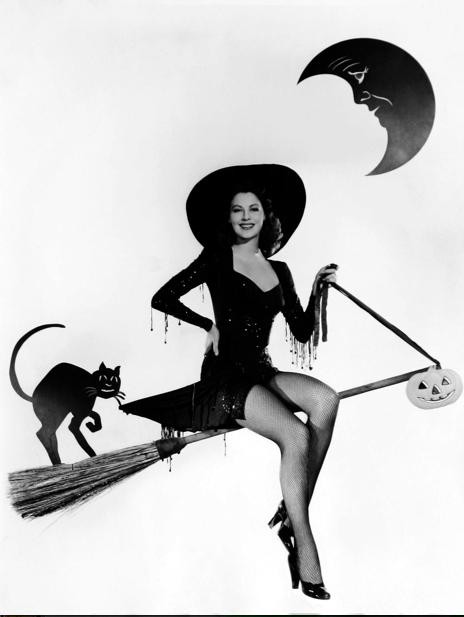
Weirdly crouched on a fake beach with high-waist shorts? Check.
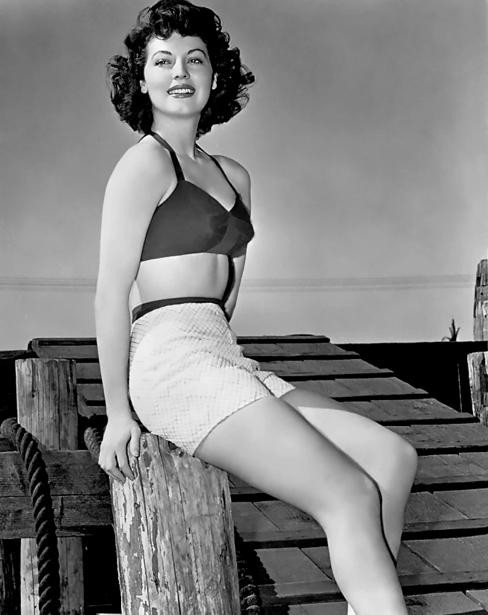
Seducing you while drinking a really thick vanilla milkshake? Check.
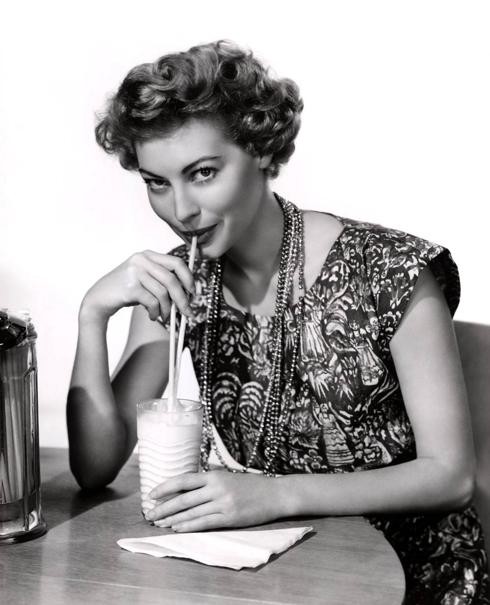
Wearing a sweater atop something that can only be described as an industrial sized firework? Check.
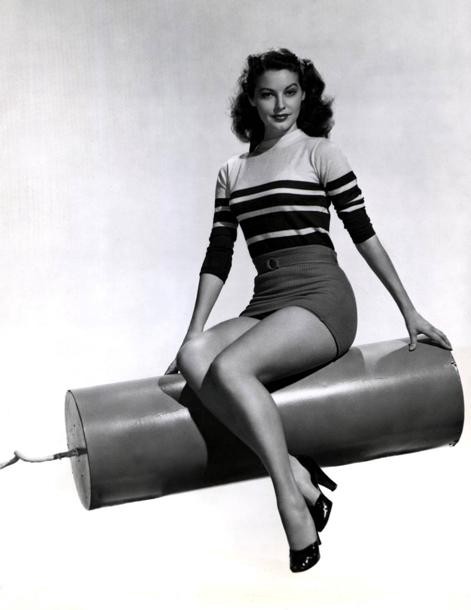
Air-humping on the beach? Ohmygod check.
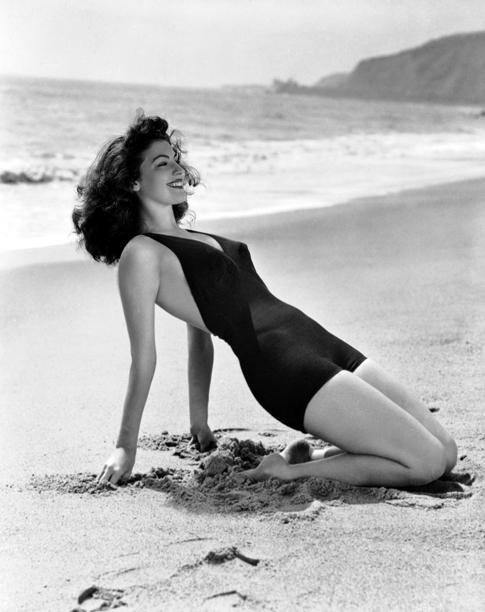
What’s even more fascinating then air-humping, however, is that Gardner was stuck as a B-girl despite the fact that she was married to the biggest star at MGM — bigger than Clark Gable, bigger than Joan Crawford. For when Gardner arrived on the studio lot in 1941, she had become the immediate target of one Mickey Rooney, who, at all of 21, had been Hollywood’s biggest box office draw for three years running.
Rooney met Gardner and asked her out on a date, but she deferred because of Southern manners and the fact that he only came up to her chin. But Rooney was persistent: He was hot shit, and he would have his hot date. Gardner eventually gave in, but refused to marry Rooney until she was 19. When she did agree, the wedding had to be approved by the MGM brass and chaperoned in full.
So they got married. Can you imagine being married to Mickey Rooney? The star with the face of an 11-year-old boy? Wouldn’t you just play connect-the-dots with his freckles? I mean, isn’t there something really wrong with this picture?

But Rooney was also a bit of a dick — there are heartbreaking stories about the way he treated Judy Garland when she was head-over-heels for him in the late ’30s — and the marriage to Gardner lasted but a year.
Gardner then started hanging out with Howard Hughes. This is the point in the post when your vision of her turns to one of Kate Beckinsale dressed in an emerald green dress playing hard-to-get with Leonardo DiCaprio in a Scorsese film. Hughes promised her the world — if you want boats, Ava, I’ll buy you all the boats! All of them! I’ll put you in all the movies! Every last one of them! — but the spark wasn’t there, and she refused his repeated marriage proposals.
Instead of Hughes, Gardner decided to marry band leader and clarinetist Artie Shaw, who had already gone through four wives, including Ms. Lana Turner. Gardner liked that Shaw was a smarty-pants who stayed up late to discuss world affairs, philosophy, and “long hair music” with his friends. But Shaw was pretty much the worst sort of autodidact, shaming Gardner for all that she didn’t know. According to Gardner, “If I remained silent when we were with friends he would say, ‘Why don’t you talk? Have you nothing to contribute?’ But when I tired to say something he would shout, ‘Shut up!’”
OH MY GOD DOES THIS GUY SUCK OR WHAT. It’s one thing to play the clarinet, I mean, I can get over that, so long as you don’t carry it around in a little clarinet purse, but it’s quite another to marry Ava Gardner and then mentally abuse her. But Gardner did her best to appease Shaw, taking extension classes at UCLA before the huge bastard up and left her for a writer of popular women’s fiction. IRONIC.
During this period, MGM continued to ignore her, lending her to Universal for The Killers, a noir based on Hemingway’s truly incredible short story. This film was a revelation, and made stars of both Gardner and Burt Lancaster.
Crucially, Gardner plays a classic femme fatale, slinking and double-crossing her way through the film in skin-tight gowns. Obviously now is the point when you turn down the volume on your work computer and watch this clip from the film, starting at about 7:00.
First, just look at that back. Now look at that dress. I really don’t understand why we don’t wear asymmetrical dresses at all times. If you need me, I’ll just be in my closet cutting one strap off of all of my dresses.
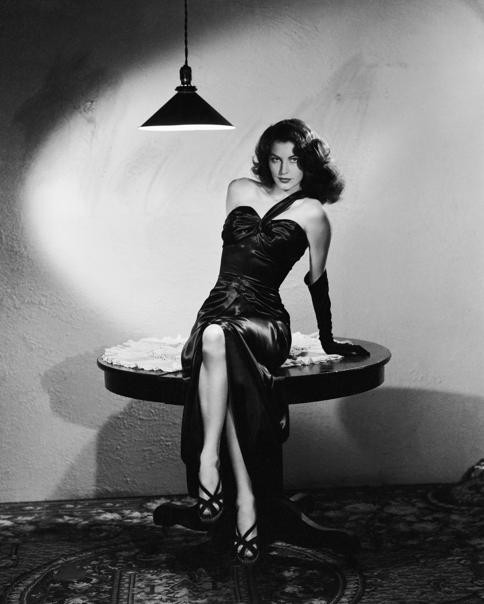
Now look at the way she plays Nice Girl but actually Super Mean Girl / Steal-Your-Boyfriend in Ten-Seconds Girl? That voice, the way she completely ignores the existing Girlfriend-Unfortunately-Dressed-Like-An-American-Doll while talking to Hubba Hubba Burt Lancaster — and how Lancaster clearly only has eyes for Gardner from that point forward?
And this, dear Hairpinners, was what Ava Gardner came to mean in the minds of millions of Americans. The fact that she had already gone through two husbands only helped to amplify the image, as did the string of similarly femme fatale-ish roles that followed. This girl had a devilish look in her eye, was clearly bad news, could drink you under the table, and could steal every man in sight. But oh my actual god was she beautiful.
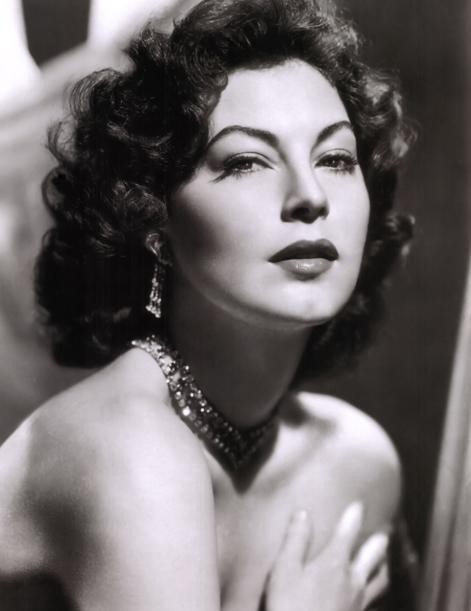
When Humphrey Bogart saw the film, he proclaimed, “Whatever it is, whether you’re born with it, or catch it from a public drinking cup, she’s got it.” (I don’t know about you guys, but maybe I got “it” from going in a nasty Idaho hot tub?)
In the wake of The Killers, Gardner became a huge f-ing deal. Her picture was all over the fan magazines, while her personal life and stream of boyfriends provided ample dish for the gossip columns. As the Saturday Evening Post explained,
The way the public thinks of her goes something like this: “Here’s a girl who, at the age of 23, had already been married and divorced twice, both times for men nobody has ever though of calling Little Lord Fauntleroys. The gossip columnists have linked her name with various members of the Hollywood wolf pack, and a girl who photographs the way she does and acts those movie hotchas as convincingly as she acts them is bound to be a warm dish in private life too.
Hollywood wolf pack! Movie hotchas! I just had to look that up on urbandictionary.com and apparently it means “Mad Hottie!” Or maybe that’s just what some eighth grader with too much time on his hands decided it meant? Either way, the gossip industry worked hard to portray Gardner as out “every night with a new beau, dripping orchids and mink, and probably having a heavy late date or two afterward.” (Seriously, though, what’s a heavy late date? Morning sex? A 4 a.m. snack of french fries? I’m so confused.) Gardner insisted that she was staying home, hanging out with Zero Boyfriends, and wearing granny pajamas, and I’m sure the truth was somewhere in between.
Case in point: this picture of her being all free and white blousey on a bicycle.
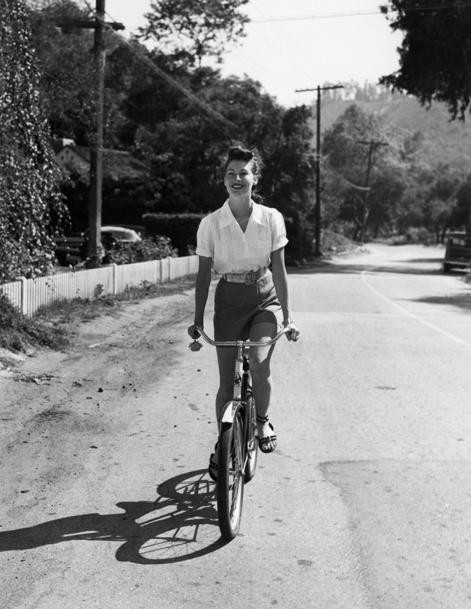
It’s clear that Gardner wasn’t lying around in asymmetrical dresses all the time sipping martinis. But I’m also not so sure that she was a granny pajama or no-boyfriend type of girl.
Whichever was the case, MGM realized it had a huge star on its hands, immediately casting her in a string of pictures and donning her “the second-look girl.” Between 1948 and 1952, Gardner appeared in 13 films, but between hits she became embroiled in a scandalous, tumultuous, roller-coaster of a relationship.
The relationship was with Frank Sinatra, and began when Sinatra’s career was at a low and his marriage to Nancy Sinatra, the mother of his three children, was in shambles. Ever since moving to Hollywood, Frank had cheated on his wife repeatedly and flagrantly, but their Catholicism had prevented a divorce. At some point in the late ’40s, however, Sinatra began having heavy late dates with Gardner while his wife stayed home and cared for their newborn child. Frank and Nancy separated on Valentine’s Day 1950 and were divorced in 1951, allowing Sinatra and Gardner to marry 10 days later and making Gardner a certified home-wrecker.
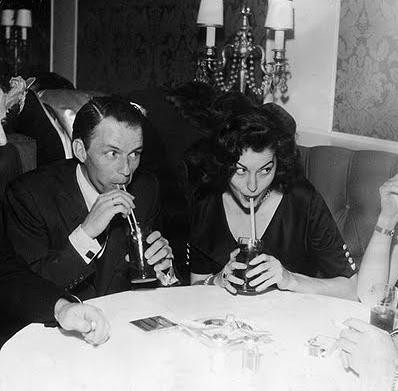
Obviously this was a bit of an asshole move on both of their parts. But oh shit was it good gossip, fueled by rumors of apparent suicide attempts (during one fight over the phone, Sinatra got so angry that he fired a gun — apparently into a mattress — to scare Gardner into thinking that he had shot himself).
The old biddy gossip columnists moralized and condemned while the fan magazines did their best to explain why the marriage wouldn’t work. Modern Screen, for example, insisted that “Ava is a girl with simple tastes. She likes blue jeans and shirts, no makeup, lots of children and family ties. Frank is a city boy who goes in for natty clothes, hectic night life, and strange acquaintances. All Ava wants is a house of her own, a husband of her own and babies of her own.”
I CALL BULLSHIT, FAN MAGAZINE. That’s like when Us tries to tell me that all Jennifer Aniston wants is a baby and that’s why she’s doing so much yoga in Hawaii with her new man. . . . .when we all know that she’s actually just tanning, maintaining her triceps, smoking weed, and having her own heavy late dates. I get so stabby when national magazines try to turn every story with a woman at its center into cry for babies. (But I do love how Modern Screen hints at Sinatra’s “strange acquaintances” a.k.a. THE MOTHERFUCKING MOB.)
Gardner had always been a fighter — she and Hughes had thrown things at each other all the time, and she and Shaw routinely got in screaming matches. But she and Sinatra fought on an entirely different level, in part because Gardner’s career was soaring while Sinatra’s was hanging around in the toilet.
Obviously this was a recipe for disaster. It’s like Gardner was the gorgeous high-powered CEO going off to make millions every day, and Sinatra was the mopey yet talented boyfriend who sat at home in his underwear, eating cereal with whiskey for breakfast. With his movie and music contracts cancelled, Sinatra could only get jobs in the equivalent of Indian Casinos. He was a sad sack indeed, and increasingly resentful of Gardner.
So Gardner did what anyone would do in her place: She got f-ing sick of his whining, pulled some strings to get him a job, and flew to Europe. But she didn’t just get him any job. She got him a choice role in Burt Lancaster’s From Here to Eternity.
Have you seen this movie? Burt Lancaster! Monty Clift! Donna Reed as a prostitute! Making out on the beach in shorty shorts! So hot right now! Sinatra won an Academy Award for his performance, effectively putting his career back on track. But the rejuvenation had come at a price, and when Gardner left to shoot The Barefoot Contessa in Spain, it was clear that the marriage was beginning to unravel. Each was accusing the other of cheating, the fan magazines were fueling rumors of each other cheating, each was indeed actually cheating.
Confidential Magazine did its best to fuel the scandalous fire, using photos of Gardner with Sammy Davis Jr., taken during a break from a photo shoot for Ebony, to insinuate a romance between the two, despite the fact that Sinatra himself had been present at the shoot.
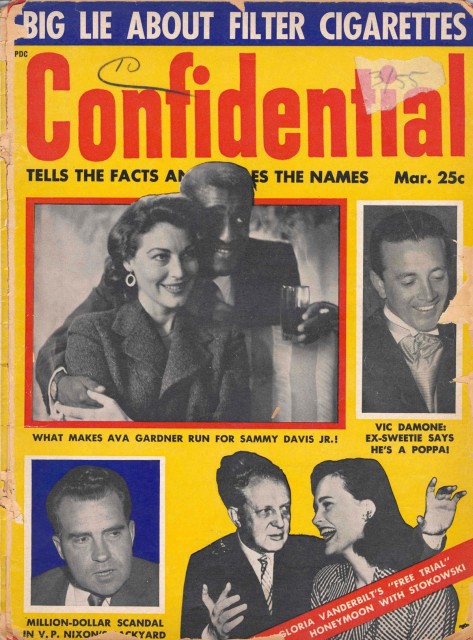
As unfounded as (most) of the rumors were, they drove Sinatra crazy. The two fought more and more, cheated more and more, and the marriage eventually ended in divorce in 1957.
And here’s where Gardner’s life takes a sweet turn. She divorces Sinatra and moves permanently to Spain, which she had fallen in love with during the filming of Contessa. Having at this point appeared in no less than three Hemingway adaptations (The Killers, Kilimanjaro, and as Lady Brett in The Sun Also Rises) she becomes BFF with Papa himself. Hemingway introduces her to all sorts of bullfighters, the hottest of whom she seduces full-on Lady Brett-style. According to lore, she accompanied Hemingway to his villa in Cuba, and after skinny-dipping in the pool, Hemingway ordered his staff “The water is never to be emptied.”
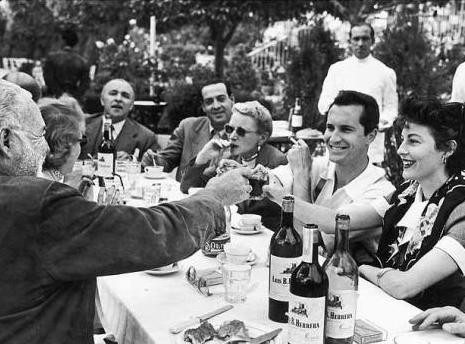
Gardner with Hemingway and hottie bull fighters during the glorious Third Act of her life.
Gardner continued to appear in films through the ’60s, most notably The Night of the Iguana, where she hung out with Dick and Liz and 5,000 paparazzi, and The Bible, where she drove George C. Scott so mad with desire that he had to be locked inside his trailer. Like the other sirens of the classic era, she slowly faded into obscurity, eventually resorting to appearances on Knot’s Landing and obscure low-budget films in order to pay the bills.
Gardner never married again, and spent her twilight years having heavy late dates with whomever she pleased, keeping an apartment in London, and hanging out with her small dogs before dying at the age of 64 from emphysema. Frank Sinatra wept like a small child when he heard the news of her death, and that water is totally still in Hemingway’s pool. Not too shabby for a Hotcha from North Carolina.
Previously: Rock Hudson, Hollywood’s Most Eligible Bachelor.
Anne Helen Petersen is a Doctor of Celebrity Gossip. No, really. You can find evidence (and other writings) here.